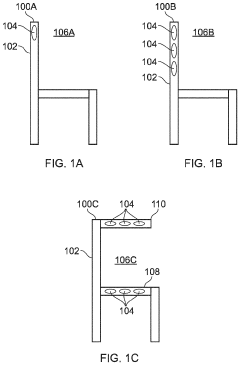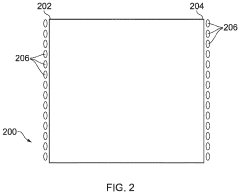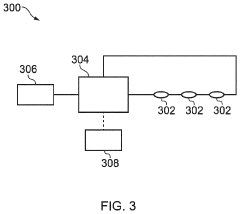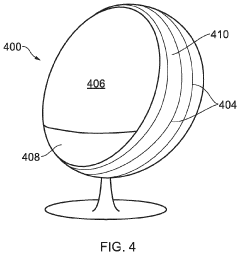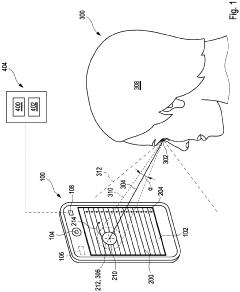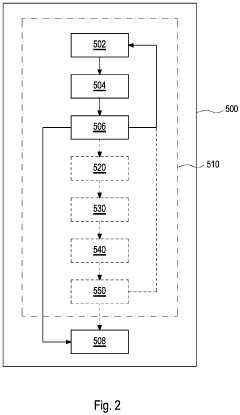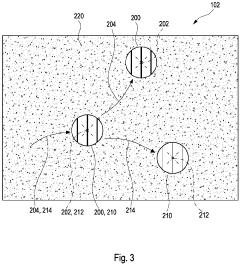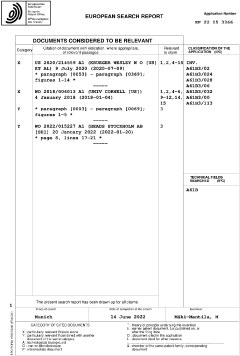Tracking Schumann Resonance: Global and Regional Perspectives
JUN 24, 20259 MIN READ
Generate Your Research Report Instantly with AI Agent
Patsnap Eureka helps you evaluate technical feasibility & market potential.
Schumann Resonance Background and Objectives
Schumann resonances, discovered by Winfried Otto Schumann in 1952, are global electromagnetic resonances generated and excited by lightning discharges in the cavity formed by the Earth's surface and the ionosphere. These resonances occur at extremely low frequencies (ELF) with fundamental modes around 7.83 Hz and harmonics at approximately 14.3, 20.8, 27.3, and 33.8 Hz.
The study of Schumann resonances has gained significant attention in recent years due to its potential applications in various fields, including atmospheric science, geophysics, and even human health. The primary objective of tracking Schumann resonances is to enhance our understanding of global electromagnetic phenomena and their interactions with the Earth's atmosphere and ionosphere.
From a global perspective, Schumann resonances provide valuable insights into the Earth's electromagnetic environment and its variations. These resonances are influenced by solar activity, ionospheric conditions, and global lightning activity, making them a useful tool for monitoring large-scale atmospheric and space weather phenomena.
Regional perspectives on Schumann resonances offer a more nuanced view of local electromagnetic conditions and their interactions with global patterns. By studying regional variations in Schumann resonance parameters, researchers can gain insights into local weather patterns, lightning activity, and ionospheric disturbances.
The evolution of Schumann resonance research has been marked by significant technological advancements in measurement techniques and data analysis. Early observations relied on simple antennas and analog recording systems, while modern studies employ sophisticated digital equipment and advanced signal processing algorithms to extract valuable information from the weak ELF signals.
Current research objectives in the field of Schumann resonance tracking include improving the accuracy and reliability of measurements, developing new methods for extracting information from resonance data, and expanding the global network of monitoring stations. These efforts aim to enhance our ability to detect and analyze subtle changes in the Earth's electromagnetic environment on both global and regional scales.
Furthermore, there is growing interest in exploring the potential applications of Schumann resonance monitoring in various domains. These include earthquake prediction, climate change studies, and investigations into the possible effects of extremely low-frequency electromagnetic fields on biological systems.
As we continue to advance our understanding of Schumann resonances, the integration of global and regional perspectives promises to yield new insights into the complex interactions between the Earth's surface, atmosphere, and near-space environment. This holistic approach will contribute to a more comprehensive understanding of our planet's electromagnetic dynamics and their implications for various natural phenomena.
The study of Schumann resonances has gained significant attention in recent years due to its potential applications in various fields, including atmospheric science, geophysics, and even human health. The primary objective of tracking Schumann resonances is to enhance our understanding of global electromagnetic phenomena and their interactions with the Earth's atmosphere and ionosphere.
From a global perspective, Schumann resonances provide valuable insights into the Earth's electromagnetic environment and its variations. These resonances are influenced by solar activity, ionospheric conditions, and global lightning activity, making them a useful tool for monitoring large-scale atmospheric and space weather phenomena.
Regional perspectives on Schumann resonances offer a more nuanced view of local electromagnetic conditions and their interactions with global patterns. By studying regional variations in Schumann resonance parameters, researchers can gain insights into local weather patterns, lightning activity, and ionospheric disturbances.
The evolution of Schumann resonance research has been marked by significant technological advancements in measurement techniques and data analysis. Early observations relied on simple antennas and analog recording systems, while modern studies employ sophisticated digital equipment and advanced signal processing algorithms to extract valuable information from the weak ELF signals.
Current research objectives in the field of Schumann resonance tracking include improving the accuracy and reliability of measurements, developing new methods for extracting information from resonance data, and expanding the global network of monitoring stations. These efforts aim to enhance our ability to detect and analyze subtle changes in the Earth's electromagnetic environment on both global and regional scales.
Furthermore, there is growing interest in exploring the potential applications of Schumann resonance monitoring in various domains. These include earthquake prediction, climate change studies, and investigations into the possible effects of extremely low-frequency electromagnetic fields on biological systems.
As we continue to advance our understanding of Schumann resonances, the integration of global and regional perspectives promises to yield new insights into the complex interactions between the Earth's surface, atmosphere, and near-space environment. This holistic approach will contribute to a more comprehensive understanding of our planet's electromagnetic dynamics and their implications for various natural phenomena.
Market Applications of Schumann Resonance Monitoring
Schumann Resonance monitoring has a wide range of market applications across various industries and research fields. In the realm of geophysics and earth sciences, Schumann Resonance data provides valuable insights into global lightning activity, ionospheric conditions, and electromagnetic phenomena. This information is crucial for climate studies, weather prediction models, and understanding long-term atmospheric changes.
The telecommunications industry benefits from Schumann Resonance monitoring as it helps in assessing the impact of ionospheric disturbances on radio wave propagation. This knowledge is essential for optimizing communication systems, particularly in long-range and satellite communications. Additionally, the aerospace sector utilizes Schumann Resonance data to improve the design and operation of aircraft and spacecraft, ensuring better electromagnetic compatibility and protection against potential disruptions.
In the field of natural disaster prediction and early warning systems, Schumann Resonance monitoring plays a significant role. Researchers have found correlations between changes in Schumann Resonance patterns and the occurrence of earthquakes, tsunamis, and severe weather events. This application has the potential to enhance existing early warning systems and improve disaster preparedness strategies.
The healthcare industry is exploring the use of Schumann Resonance monitoring in studying the effects of electromagnetic fields on human health. Some researchers suggest that exposure to Schumann Resonances may have beneficial effects on human physiology, leading to potential applications in wellness and therapeutic technologies.
Environmental monitoring and conservation efforts also benefit from Schumann Resonance data. The global nature of these resonances allows for the detection of large-scale environmental changes, such as shifts in global temperature patterns or alterations in the Earth's magnetic field. This information is valuable for climate change research and environmental impact assessments.
The energy sector, particularly renewable energy companies, can utilize Schumann Resonance monitoring to optimize the placement and operation of wind and solar farms. Understanding the electromagnetic environment can help in minimizing interference and maximizing energy production efficiency.
Lastly, the emerging field of space weather forecasting relies on Schumann Resonance data to predict solar storms and their potential impact on Earth's technological infrastructure. This application is crucial for protecting power grids, satellite operations, and other critical systems from solar-induced electromagnetic disturbances.
The telecommunications industry benefits from Schumann Resonance monitoring as it helps in assessing the impact of ionospheric disturbances on radio wave propagation. This knowledge is essential for optimizing communication systems, particularly in long-range and satellite communications. Additionally, the aerospace sector utilizes Schumann Resonance data to improve the design and operation of aircraft and spacecraft, ensuring better electromagnetic compatibility and protection against potential disruptions.
In the field of natural disaster prediction and early warning systems, Schumann Resonance monitoring plays a significant role. Researchers have found correlations between changes in Schumann Resonance patterns and the occurrence of earthquakes, tsunamis, and severe weather events. This application has the potential to enhance existing early warning systems and improve disaster preparedness strategies.
The healthcare industry is exploring the use of Schumann Resonance monitoring in studying the effects of electromagnetic fields on human health. Some researchers suggest that exposure to Schumann Resonances may have beneficial effects on human physiology, leading to potential applications in wellness and therapeutic technologies.
Environmental monitoring and conservation efforts also benefit from Schumann Resonance data. The global nature of these resonances allows for the detection of large-scale environmental changes, such as shifts in global temperature patterns or alterations in the Earth's magnetic field. This information is valuable for climate change research and environmental impact assessments.
The energy sector, particularly renewable energy companies, can utilize Schumann Resonance monitoring to optimize the placement and operation of wind and solar farms. Understanding the electromagnetic environment can help in minimizing interference and maximizing energy production efficiency.
Lastly, the emerging field of space weather forecasting relies on Schumann Resonance data to predict solar storms and their potential impact on Earth's technological infrastructure. This application is crucial for protecting power grids, satellite operations, and other critical systems from solar-induced electromagnetic disturbances.
Current Challenges in Tracking Schumann Resonance
Tracking Schumann Resonance (SR) presents several significant challenges that researchers and scientists must overcome to obtain accurate and reliable data. One of the primary difficulties lies in the extremely low frequency of SR signals, typically ranging from 7.83 Hz to 60 Hz. These low-frequency waves are susceptible to various forms of interference, making it challenging to isolate and measure them accurately.
Environmental factors pose a considerable obstacle in SR tracking. Natural phenomena such as lightning storms, solar activity, and geomagnetic disturbances can significantly affect SR measurements. Additionally, human-made electromagnetic noise from power lines, electronic devices, and industrial activities can mask or distort SR signals, particularly in urban areas.
The global nature of SR tracking adds another layer of complexity. To obtain a comprehensive understanding of SR phenomena, measurements need to be taken at multiple locations worldwide. This requirement necessitates the establishment and maintenance of a network of synchronized monitoring stations, which can be logistically challenging and costly.
Instrumentation for SR tracking presents its own set of challenges. Highly sensitive magnetometers and antennas are required to detect the weak SR signals. These instruments must be carefully calibrated and shielded from external electromagnetic interference to ensure accurate measurements. The development and deployment of such specialized equipment can be both technically demanding and expensive.
Data processing and analysis pose significant challenges in SR tracking. The vast amount of data collected from multiple stations requires sophisticated algorithms and computational resources to extract meaningful information. Distinguishing SR signals from background noise and identifying subtle variations in frequency and amplitude demand advanced signal processing techniques.
Long-term monitoring of SR is crucial for understanding its relationship with global climate patterns and potential applications in early warning systems for natural disasters. However, maintaining consistent data quality over extended periods and ensuring the continuity of measurements across different instruments and locations present ongoing challenges.
The interpretation of SR data in the context of global and regional perspectives adds another layer of complexity. Researchers must consider the influence of local geological features, ionospheric conditions, and seasonal variations on SR measurements. Developing models that accurately represent the global SR system while accounting for regional variations remains a significant challenge in the field.
Environmental factors pose a considerable obstacle in SR tracking. Natural phenomena such as lightning storms, solar activity, and geomagnetic disturbances can significantly affect SR measurements. Additionally, human-made electromagnetic noise from power lines, electronic devices, and industrial activities can mask or distort SR signals, particularly in urban areas.
The global nature of SR tracking adds another layer of complexity. To obtain a comprehensive understanding of SR phenomena, measurements need to be taken at multiple locations worldwide. This requirement necessitates the establishment and maintenance of a network of synchronized monitoring stations, which can be logistically challenging and costly.
Instrumentation for SR tracking presents its own set of challenges. Highly sensitive magnetometers and antennas are required to detect the weak SR signals. These instruments must be carefully calibrated and shielded from external electromagnetic interference to ensure accurate measurements. The development and deployment of such specialized equipment can be both technically demanding and expensive.
Data processing and analysis pose significant challenges in SR tracking. The vast amount of data collected from multiple stations requires sophisticated algorithms and computational resources to extract meaningful information. Distinguishing SR signals from background noise and identifying subtle variations in frequency and amplitude demand advanced signal processing techniques.
Long-term monitoring of SR is crucial for understanding its relationship with global climate patterns and potential applications in early warning systems for natural disasters. However, maintaining consistent data quality over extended periods and ensuring the continuity of measurements across different instruments and locations present ongoing challenges.
The interpretation of SR data in the context of global and regional perspectives adds another layer of complexity. Researchers must consider the influence of local geological features, ionospheric conditions, and seasonal variations on SR measurements. Developing models that accurately represent the global SR system while accounting for regional variations remains a significant challenge in the field.
Existing Methods for Global and Regional SR Tracking
01 Devices for measuring and analyzing Schumann resonance
Various devices and systems have been developed to measure and analyze Schumann resonance. These include specialized sensors, antennas, and signal processing equipment designed to detect and track the extremely low frequency electromagnetic waves associated with Schumann resonance. Such devices often incorporate advanced filtering techniques to isolate the Schumann resonance signal from background noise.- Devices for measuring and analyzing Schumann resonance: Various devices and systems have been developed to measure and analyze Schumann resonance. These include specialized sensors, antennas, and signal processing equipment designed to detect and track the low-frequency electromagnetic waves associated with Schumann resonance. Such devices often incorporate advanced filtering techniques to isolate the Schumann resonance signals from background noise.
- Applications in health and wellness: Schumann resonance tracking has found applications in health and wellness fields. Some devices are designed to generate or simulate Schumann resonance frequencies, which are believed by some to have potential therapeutic effects. These applications range from stress reduction to improving sleep quality and overall well-being.
- Integration with wearable technology: Schumann resonance tracking is being integrated into wearable technology. This includes the development of portable devices and accessories that can monitor and potentially interact with Schumann resonance frequencies. Such wearables aim to provide users with real-time data and potential health benefits associated with these natural electromagnetic frequencies.
- Environmental monitoring and research: Schumann resonance tracking is utilized in environmental monitoring and research. Scientists use specialized equipment to study variations in Schumann resonance as indicators of global climate patterns, ionospheric conditions, and other geophysical phenomena. This research contributes to our understanding of Earth's electromagnetic environment and its potential impacts on various systems.
- Advanced signal processing techniques: Researchers are developing advanced signal processing techniques to improve the accuracy and reliability of Schumann resonance tracking. These methods include novel algorithms for noise reduction, signal extraction, and data analysis. Such advancements aim to enhance the sensitivity and precision of Schumann resonance measurements, enabling more detailed studies of this phenomenon.
02 Applications in health and wellness
Schumann resonance tracking has found applications in health and wellness fields. Some devices are designed to generate or simulate Schumann resonance frequencies, which are believed by some to have potential therapeutic effects. These applications range from stress reduction to improving sleep quality and overall well-being.Expand Specific Solutions03 Integration with wearable technology
Recent developments have seen the integration of Schumann resonance tracking capabilities into wearable devices. These wearables can monitor and potentially interact with Schumann resonance frequencies, offering users real-time data and insights. Such devices may combine Schumann resonance tracking with other biometric measurements for comprehensive health monitoring.Expand Specific Solutions04 Environmental monitoring and geophysical research
Schumann resonance tracking is utilized in environmental monitoring and geophysical research. Systems have been developed to study the relationship between Schumann resonances and various atmospheric and geological phenomena. This includes applications in weather prediction, earthquake forecasting, and monitoring global electromagnetic activity.Expand Specific Solutions05 Advanced signal processing and data analysis techniques
Sophisticated signal processing and data analysis techniques have been developed for Schumann resonance tracking. These include advanced algorithms for noise reduction, signal extraction, and spectral analysis. Machine learning and artificial intelligence methods are also being applied to improve the accuracy and interpretation of Schumann resonance data.Expand Specific Solutions
Key Players in Schumann Resonance Research
The field of tracking Schumann Resonance is in a nascent stage of development, with growing interest from both academic and industrial sectors. The market size is relatively small but expanding, driven by applications in geophysics, climate research, and potential health implications. Technologically, it's still evolving, with varying levels of maturity among key players. Companies like Siemens Healthineers AG and Koninklijke Philips NV are leveraging their expertise in sensing technologies, while academic institutions such as MIT and Johns Hopkins University are contributing fundamental research. Collaborations between industry and academia, exemplified by partnerships involving Fraunhofer-Gesellschaft and various universities, are accelerating technological advancements in this niche but promising field.
Massachusetts Institute of Technology
Technical Solution: MIT has developed a global network of ELF (Extremely Low Frequency) receivers to monitor Schumann resonances continuously. Their system uses advanced signal processing techniques to extract Schumann resonance data from background noise. The data is analyzed in real-time to track global lightning activity, study ionospheric variations, and investigate potential correlations with geophysical phenomena. MIT's approach combines hardware innovations with sophisticated software algorithms to achieve high sensitivity and temporal resolution in Schumann resonance measurements.
Strengths: Cutting-edge technology, global coverage, real-time data analysis. Weaknesses: High cost of maintaining a global network, potential for interference from local electromagnetic sources.
Centre National de la Recherche Scientifique
Technical Solution: CNRS has implemented a multi-station approach to tracking Schumann resonances, with monitoring sites across France and its overseas territories. Their system employs custom-designed magnetic antennas and low-noise amplifiers to detect the weak magnetic field components of Schumann resonances. CNRS researchers have developed advanced spectral analysis techniques to separate Schumann resonance signals from cultural noise and geomagnetic pulsations. They also focus on studying the relationship between Schumann resonances and various atmospheric and space weather phenomena.
Strengths: Wide geographical distribution of monitoring stations, expertise in signal processing. Weaknesses: Limited to French territories, potential gaps in global coverage.
Innovations in Schumann Resonance Measurement Techniques
A magnetic field exposure system and uses thereof
PatentPendingUS20230372726A1
Innovation
- A magnetic field exposure system generating an amplitude-modulated low frequency magnetic field with a carrier frequency of 360 to 450 Hz and a modulation frequency of 0.5 to 100 Hz, providing a field strength of 0.5 to 250 μT, specifically designed to enhance cell survival, proliferation, reduce stress, and promote tissue regeneration.
Method and apparatus for determining at least one visual parameter
PatentInactiveEP4218542A1
Innovation
- A computer-implemented method and apparatus that displays two dynamic visual stimuli simultaneously on a screen to elicit eye movements, using an eye-tracking device to generate tracking data, which is then processed to determine visual parameters like refractive error and visual performance without the need for additional patient responses.
Environmental Factors Affecting Schumann Resonance
The Schumann resonance, a set of spectral peaks in the Earth's electromagnetic field spectrum, is influenced by various environmental factors that can significantly affect its characteristics and detection. These factors play a crucial role in understanding the global and regional perspectives of tracking Schumann resonance.
Atmospheric conditions, particularly those in the lower ionosphere, have a substantial impact on Schumann resonance. Changes in ionospheric height and electron density can alter the resonance frequencies and amplitudes. Solar activity, including solar flares and geomagnetic storms, can cause ionospheric disturbances that directly affect the Schumann resonance. During periods of high solar activity, the resonance frequencies may shift, and the signal strength can be enhanced or suppressed.
Lightning activity, the primary source of excitation for Schumann resonance, is another critical environmental factor. The global distribution of thunderstorms, which varies with seasons and geographical locations, influences the intensity and characteristics of the resonance. Regions with high lightning activity, such as the tropics, contribute more significantly to the global Schumann resonance signal.
Climate patterns and weather phenomena also play a role in modulating Schumann resonance. El Niño and La Niña events, for instance, can alter global lightning patterns and, consequently, affect the resonance. Severe weather events, such as hurricanes and typhoons, can create localized changes in the resonance characteristics.
Human activities and technological advancements have introduced additional environmental factors affecting Schumann resonance. Electromagnetic pollution from power lines, radio transmissions, and other human-made sources can interfere with the detection and analysis of the resonance. Urbanization and changes in land use patterns may also influence local electromagnetic fields and, by extension, the Schumann resonance measurements in certain areas.
The Earth's magnetic field variations, both long-term secular changes and short-term fluctuations, can impact Schumann resonance. These variations can affect the propagation of electromagnetic waves in the Earth-ionosphere cavity, leading to changes in resonance characteristics.
Understanding and accounting for these environmental factors is crucial for accurate tracking and interpretation of Schumann resonance data. Researchers must consider these influences when analyzing global and regional perspectives, ensuring that observed variations are correctly attributed to natural phenomena or anthropogenic sources.
Atmospheric conditions, particularly those in the lower ionosphere, have a substantial impact on Schumann resonance. Changes in ionospheric height and electron density can alter the resonance frequencies and amplitudes. Solar activity, including solar flares and geomagnetic storms, can cause ionospheric disturbances that directly affect the Schumann resonance. During periods of high solar activity, the resonance frequencies may shift, and the signal strength can be enhanced or suppressed.
Lightning activity, the primary source of excitation for Schumann resonance, is another critical environmental factor. The global distribution of thunderstorms, which varies with seasons and geographical locations, influences the intensity and characteristics of the resonance. Regions with high lightning activity, such as the tropics, contribute more significantly to the global Schumann resonance signal.
Climate patterns and weather phenomena also play a role in modulating Schumann resonance. El Niño and La Niña events, for instance, can alter global lightning patterns and, consequently, affect the resonance. Severe weather events, such as hurricanes and typhoons, can create localized changes in the resonance characteristics.
Human activities and technological advancements have introduced additional environmental factors affecting Schumann resonance. Electromagnetic pollution from power lines, radio transmissions, and other human-made sources can interfere with the detection and analysis of the resonance. Urbanization and changes in land use patterns may also influence local electromagnetic fields and, by extension, the Schumann resonance measurements in certain areas.
The Earth's magnetic field variations, both long-term secular changes and short-term fluctuations, can impact Schumann resonance. These variations can affect the propagation of electromagnetic waves in the Earth-ionosphere cavity, leading to changes in resonance characteristics.
Understanding and accounting for these environmental factors is crucial for accurate tracking and interpretation of Schumann resonance data. Researchers must consider these influences when analyzing global and regional perspectives, ensuring that observed variations are correctly attributed to natural phenomena or anthropogenic sources.
Data Integration and Analysis for SR Tracking
The integration and analysis of data for tracking Schumann Resonance (SR) is a complex process that requires sophisticated techniques and tools. This process involves collecting data from multiple sources, including ground-based ELF receivers, satellite observations, and ionospheric monitoring stations. The data collected often includes electromagnetic field measurements, atmospheric parameters, and geomagnetic indices.
One of the primary challenges in SR tracking is the need to filter out noise and interference from various sources, such as human-made electromagnetic emissions and natural phenomena like lightning strikes. Advanced signal processing techniques, including Fourier transforms and wavelet analysis, are employed to isolate the SR signals from background noise. These methods allow researchers to identify the characteristic SR frequencies and their variations over time.
Machine learning algorithms and artificial intelligence are increasingly being utilized to enhance data integration and analysis for SR tracking. These technologies can help identify patterns and correlations in the data that may not be immediately apparent to human observers. For instance, neural networks can be trained to recognize subtle changes in SR parameters that may indicate upcoming geophysical events or atmospheric disturbances.
Global SR tracking requires the coordination of data from multiple observation points around the world. This necessitates the development of standardized data formats and protocols to ensure compatibility and ease of integration. Cloud-based platforms and distributed computing systems are often employed to handle the large volumes of data generated by continuous SR monitoring.
Regional perspectives on SR tracking involve more localized data collection and analysis. This approach allows for the study of how local geological and atmospheric conditions influence SR characteristics. Regional tracking can provide valuable insights into the relationship between SR and local weather patterns, seismic activity, or ionospheric disturbances.
Real-time data processing and visualization tools are crucial for both global and regional SR tracking. These tools enable researchers to monitor SR parameters continuously and detect anomalies or trends as they occur. Interactive dashboards and 3D visualization techniques are often used to present complex SR data in an intuitive and accessible manner, facilitating rapid interpretation and decision-making.
One of the primary challenges in SR tracking is the need to filter out noise and interference from various sources, such as human-made electromagnetic emissions and natural phenomena like lightning strikes. Advanced signal processing techniques, including Fourier transforms and wavelet analysis, are employed to isolate the SR signals from background noise. These methods allow researchers to identify the characteristic SR frequencies and their variations over time.
Machine learning algorithms and artificial intelligence are increasingly being utilized to enhance data integration and analysis for SR tracking. These technologies can help identify patterns and correlations in the data that may not be immediately apparent to human observers. For instance, neural networks can be trained to recognize subtle changes in SR parameters that may indicate upcoming geophysical events or atmospheric disturbances.
Global SR tracking requires the coordination of data from multiple observation points around the world. This necessitates the development of standardized data formats and protocols to ensure compatibility and ease of integration. Cloud-based platforms and distributed computing systems are often employed to handle the large volumes of data generated by continuous SR monitoring.
Regional perspectives on SR tracking involve more localized data collection and analysis. This approach allows for the study of how local geological and atmospheric conditions influence SR characteristics. Regional tracking can provide valuable insights into the relationship between SR and local weather patterns, seismic activity, or ionospheric disturbances.
Real-time data processing and visualization tools are crucial for both global and regional SR tracking. These tools enable researchers to monitor SR parameters continuously and detect anomalies or trends as they occur. Interactive dashboards and 3D visualization techniques are often used to present complex SR data in an intuitive and accessible manner, facilitating rapid interpretation and decision-making.
Unlock deeper insights with Patsnap Eureka Quick Research — get a full tech report to explore trends and direct your research. Try now!
Generate Your Research Report Instantly with AI Agent
Supercharge your innovation with Patsnap Eureka AI Agent Platform!
